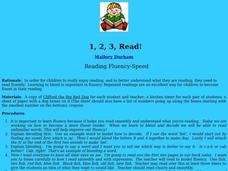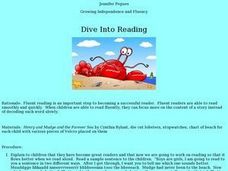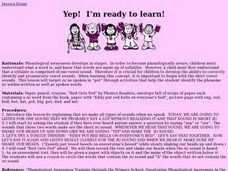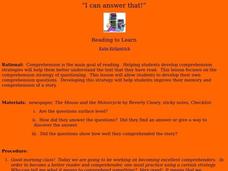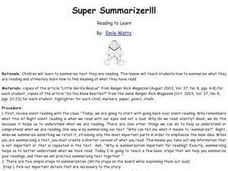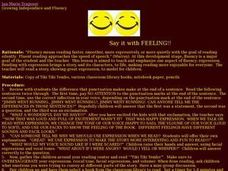Curated OER
Everybody Get Ready
Learners identify and spell words containing the short /e/ sound. They rehearse a fun tongue twister which contains words emphasizing the short /e/ sound. They then read Red Gets Fed as a class. Have your group clap every time they hear...
Curated OER
On Your Mark, Get Set, Read!
Are your beginning readers trying to build fluency? Use this activity to teach them how to monitor their reading fluency. First they get a sentence to practice with, reading it to their partner once and rereading it silently five times....
Curated OER
The Tug Says Uhh!
Kindergarteners and first graders discover the /u/ sound! After practicing making the sound with the funny tongue twister, youngsters use their Elkonin letterboxes to divide a set of words into their phonemes. Then pairs read Bud...
Curated OER
1, 2, 3, Read!
Explain to your readers a variety of decoding strategies to improve their reading fluency. They observe the teacher modeling blending, then in pairs take turns reading the book Clifford the Big Red Dog. Learners then time each other...
Curated OER
Dive Into Reading
Learners observe and demonstrate various reading strategies to improve their reading fluency. The teacher first models smooth speech. In pairs, pupils take turns reading from the book Henry and Mudge and the Forever Sea by Cynthia...
Curated OER
Yep, I'm Ready to Learn!
Tongue twisters give young learners an easy phrase to refer back to when learning letter sounds. Use the phrase "Eddy put red bells on everyone's bed" to identify the /e/ sound. Then read Red Gets Fed aloud, having learners nod...
Curated OER
The Everyday Red
Pair a hand motion with the /e/ sound so young learners remember it better! This plan has the class open their "creaky door" whenever they hear the /e/ sound. They'll learn a tongue twister and read the short story Red Gets Fed,...
Curated OER
Reading Bugs
Review the phonemic sounds of the alphabet letters before examining how to blend letter sounds to make a word. During this teacher-modeled instructional activity, learners make word bugs out of three phonemes that blend together. As an...
Curated OER
Sum It Up
After a review of the steps involved in writing a summary, class members read The Physics of Baseball by Sarah Ives and use a story web to identify the important details to include in their summary. Class members then choose an article...
Curated OER
What's the Big Deal?
Learners listen to a passage (suggested reading: "Do a Cat's Eyes Glow?") and create a map of what they hear. They use the map to write a summary. Then, they read their own passages and independently map and summarize it the same way....
Curated OER
Ollie the Own Says: WHO
Scholars examine the strategy of making a story map or outline to identify the main elements of a story. They discuss the who, what, where, when, why, and how of a story, in an outline form. As a class they read a short story, answer the...
Curated OER
I Can Answer That!
Enhance reader comprehension! Examine different comprehension strategies with your second, third, and fourth graders. They discuss the strategy of questioning by developing their own comprehension questions to help improve their memory...
Curated OER
"Aaaaaa!!!!" It's Okay, Baby!!
Your kindergarten or first grade class works on recognizing the /a/ sound in spoken words. Use the fun tongue twister to help remember the target sound, and practice writing the letter a. Then have them write words that use this target...
Curated OER
Summarizing with James and the Giant Peach
Elementary readers in literature groups practice summarizing chapter-by-chapter with Roald Dahl's James and the Giant Peach. Focus on main idea, supporting details, and the 5 Ws. Unfortunately, a clever "peach" graphic organizer to which...
Curated OER
Super Summarizer!!!
Emerging readers summarize a nonfiction text using a five step process. After a brief demonstration of the five-step method for summarizing text, they read a nonfiction article and write their own summary. A checklist of each summary is...
Curated OER
Summarizing: James and the Giant Peach
Text marking and a T-chart format to distinguish important information from trivia help elementary readers summarize effectively. Encouraging readers to construct a chapter summary from paragraph-level topic sentences is another sound...
Curated OER
Bridge to Terabithia: Visualizing to Optimize Comprehension
Good readers visualize. And in our image-rich culture it is imperative that children are provided with opportunities to practice this important skill. A selection from Shel Silverstein’s Where the Sidewalk Ends and Bridge to Terabithia,...
Curated OER
Why?
Students discuss the concept of asking questions while reading. They discuss the types of questions to ask that will improve their comprehension. Students read from a textbook and practice creating questions to ask themselves while...
Curated OER
Question What You Read
Readers test their reading comprehension after reading a nonfiction text about Paleo Indians. (This text is in Alabama: It's History and Geography, but other texts can be used.) After reading the nonfiction article as a class, they...
Curated OER
Hop on the Express Train to Read Expressively
Encourage beginning readers to read expressively. After the teacher models what it's like to read with expression, pairs of learners work together to practice developing this ability. While one learner reads, the other marks a check-list...
Curated OER
Say it with FEELING!
Why should we read with expression when we read? Engage your learners in this discussion and teach them the easiest way to gauge expression: the end mark! Is it a question mark? An exclamation point? This helps you determine how to...
Curated OER
Expressive Eloquent Experts
What does it mean to read expressively? Beginning readers hear examples of expressive reading and partner up to practice. One partner reads The Littlest Pumpkin and the other partner reads Franklin and his Friend. While...
Curated OER
Iggy the Penguin
Take your young word detectives on a hunt for the /i/ sound. Use the tongue twister about Iggy the penguin to help learners identify the target sound. Then learners are given several words, and they have to use their detective skills to...
Curated OER
OW! I stubbed by toe
Drill and practice the /ow/ sound! Kids practice recognizing pictures that begin with the ou=/ou/ correspondence. They experience a letterbox lesson to help implement this task before them as well as reading the story, The Napping House,...





